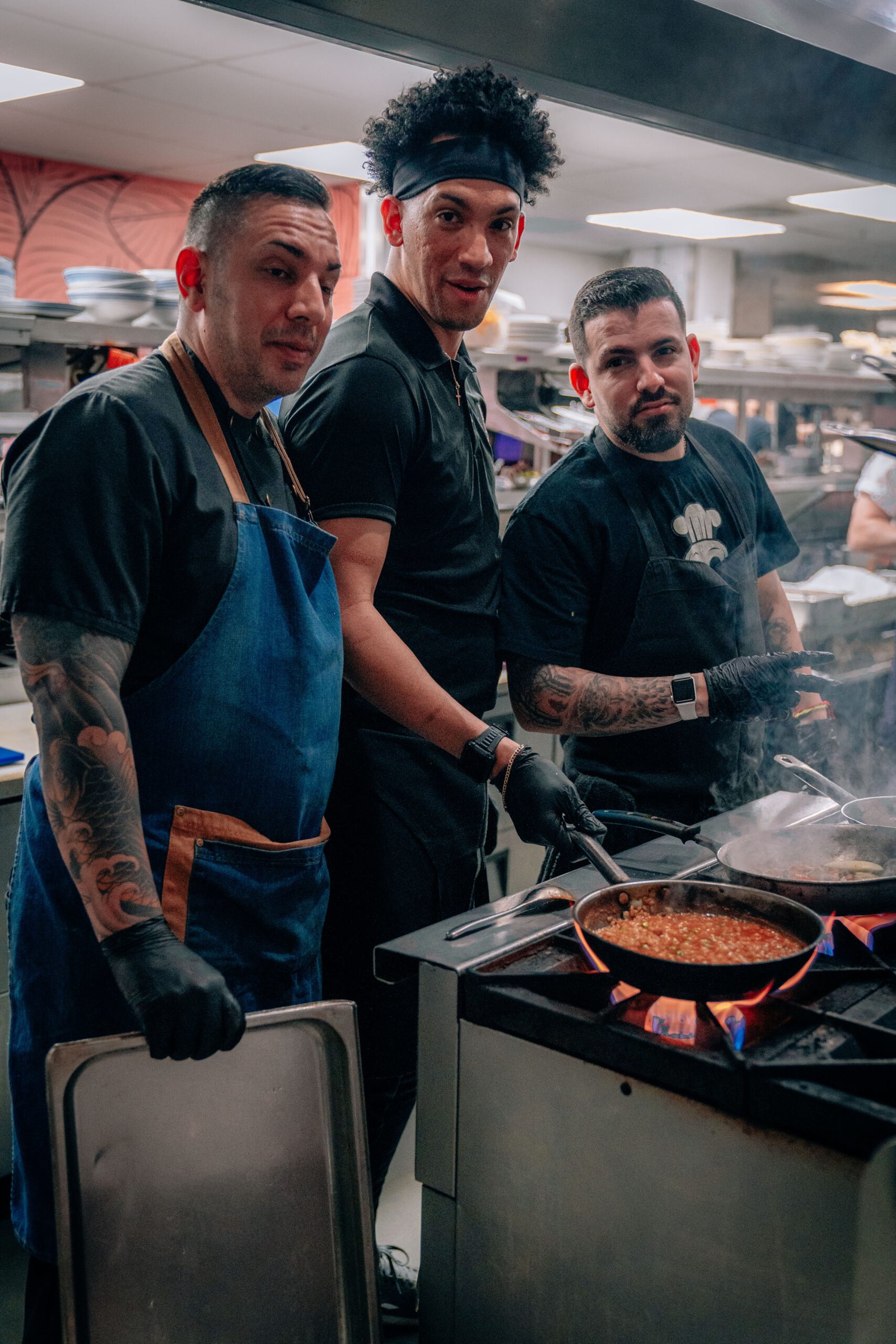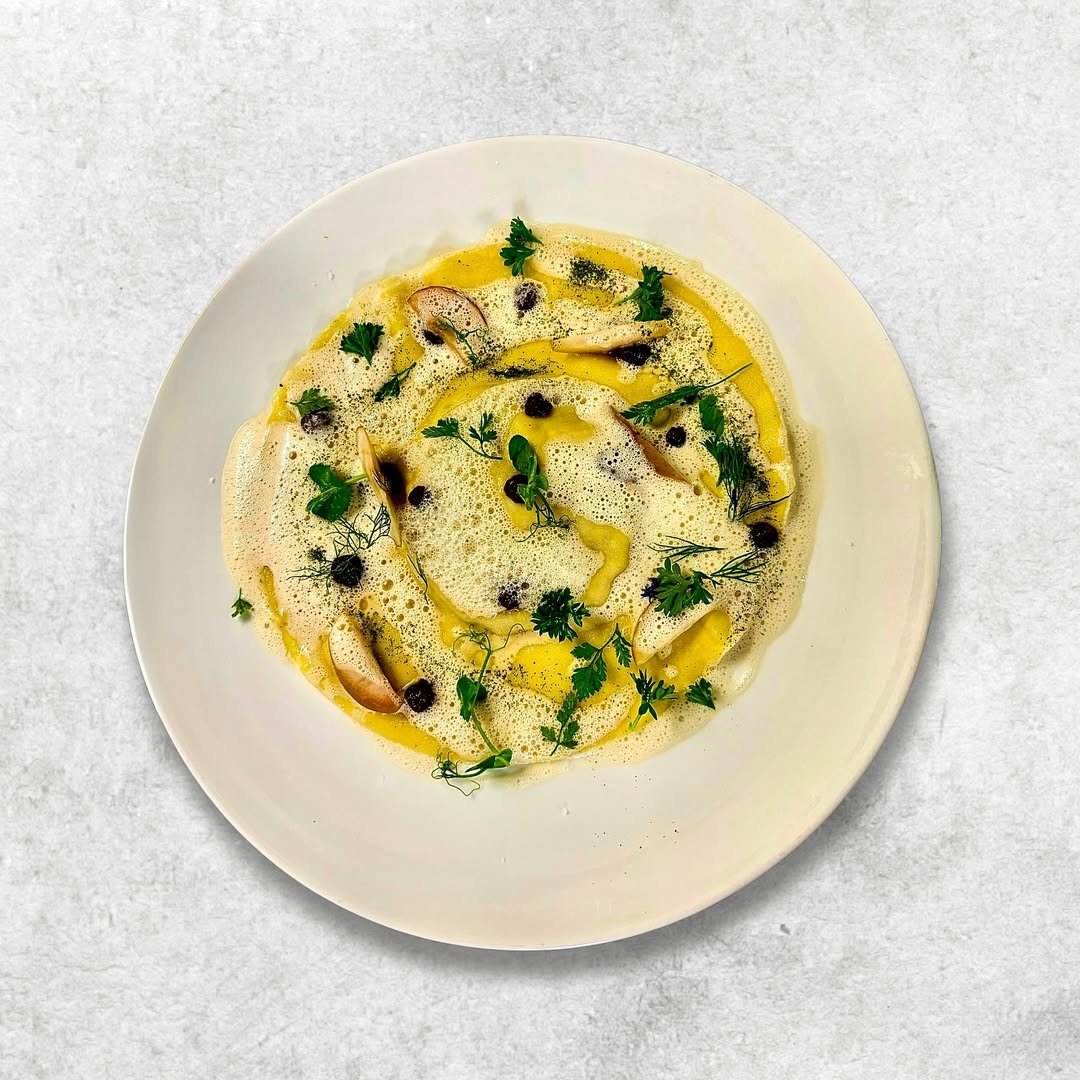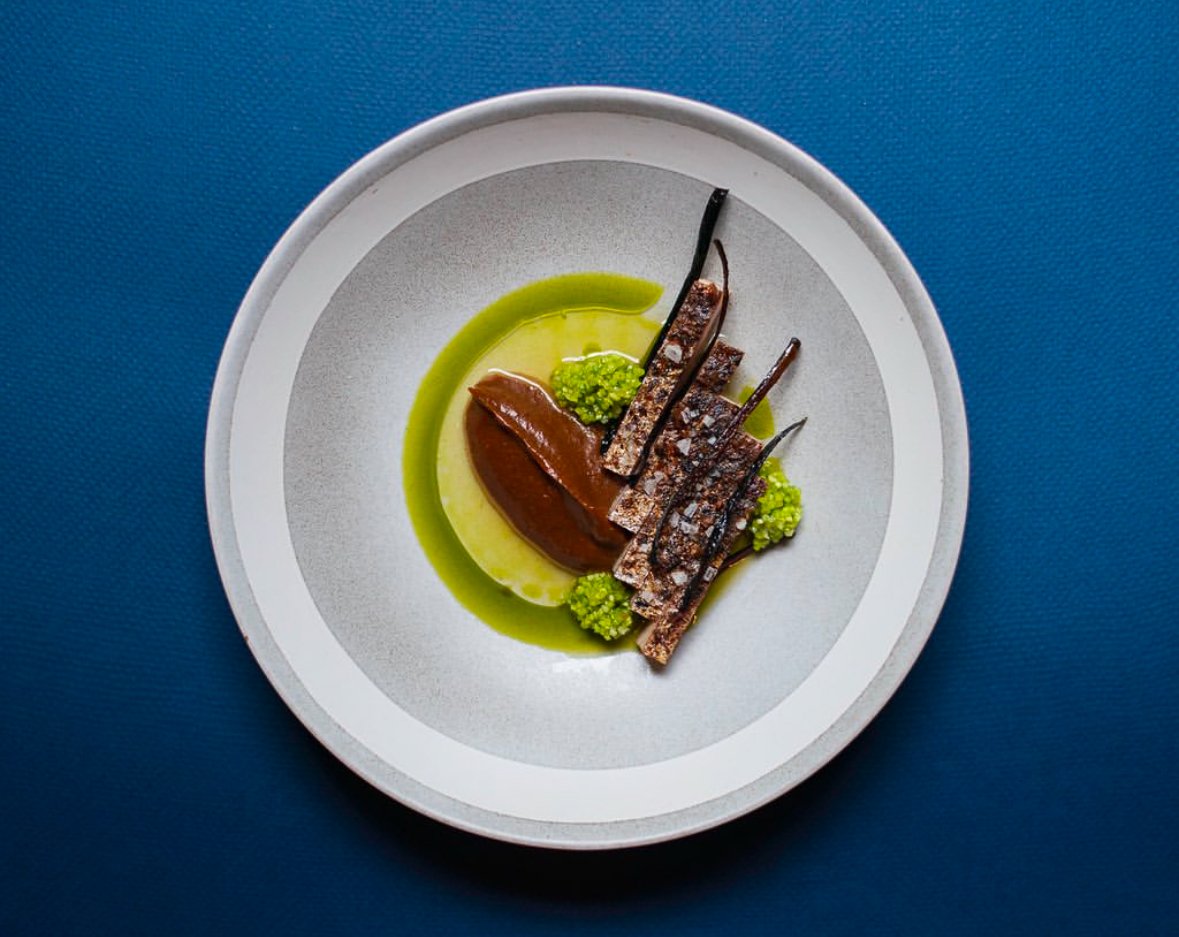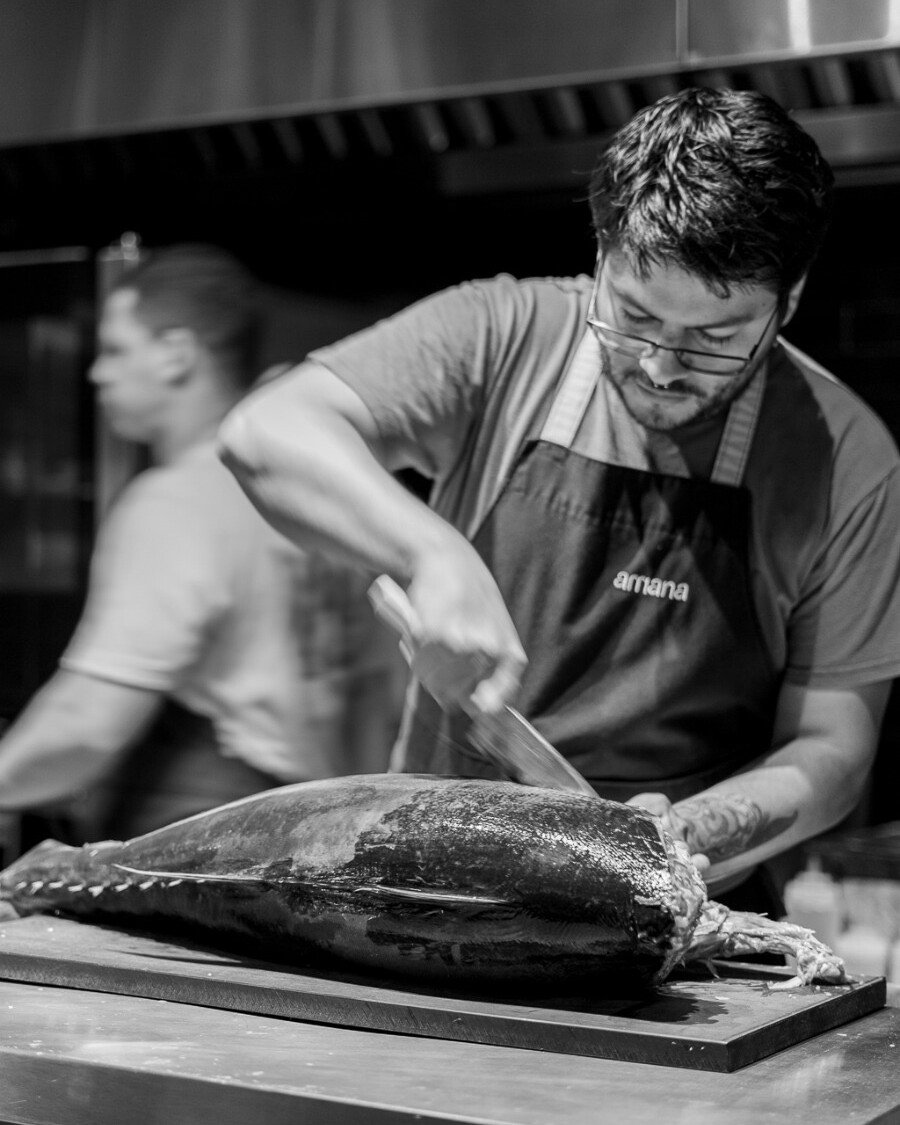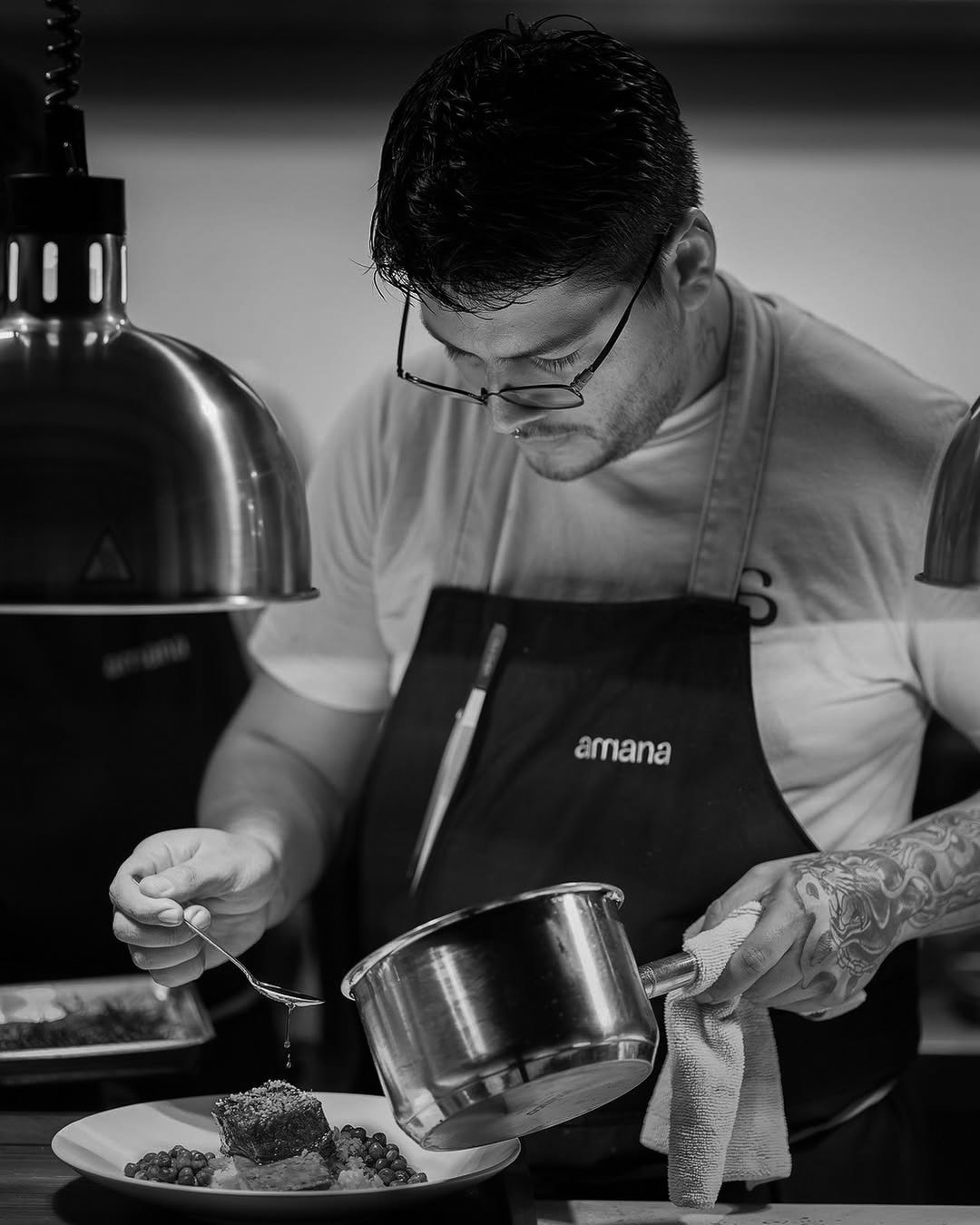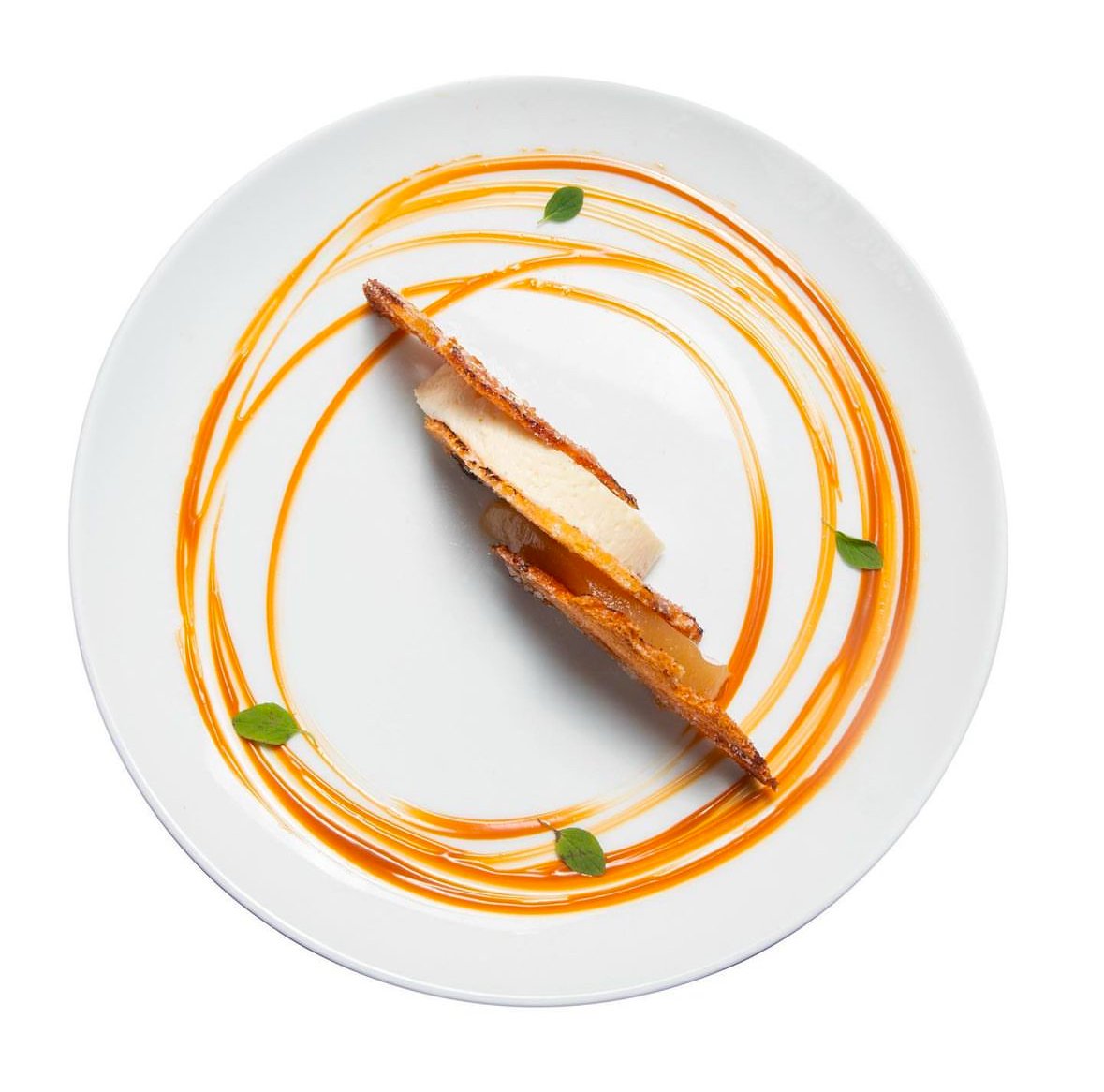Home Has No Borders
Humans of the Kitchen
Carrying Cuba in every dish, finding home in every kitchen.

Lazaro Javier Hernández González
Cuba was always my starting point, but never my limit. Like every Cuban kid, I dreamed of Miami. Today, after a journey that took me through Nicaragua, Mexico, and even Qatar, I’m here, living that dream – but with my feet firmly planted in the kitchen.”
I’ve been cooking for over 11 years now. It started in Cuba, where I studied food processing. My mom worked at a restaurant, and that’s where I got my first chance. My whole family is in hospitality – my mom was a cashier, my brothers are bartenders… and me, I’m the cook.
From the beginning, I knew this was it for me. No doubt.
I’ve carried Cuban food with me around the world. I cooked in Russia, in Qatar, always holding my flag high. Every place has its own culture, its own rules, different religions – but Cuban food, for me, always has the same soul. Ropa vieja, congrí, that flavor you just can’t fake.
“What do I feel cooking Cuban food outside of Cuba? Pride. It’s in my blood. It’s how I stay present, no matter where I am.”
I’ve worked with people from all over – Filipinos, Nepalis, Mexicans. In the kitchen, we’re all the same. We understand each other without even speaking the same language. It’s something you only live when you’re in it, between the pots and the flames. I’ve never felt like I chose the wrong path. Not even when I was far from home. The kitchen has always held me.
Now in Miami, after a year and a half, I feel like I’ve grown a lot, but I’m just getting started. I want to keep learning, keep exploring, and give my all to whatever comes next. Focused. Because this path is mine, and there’s still a long way to go.
Photos by @pedrojsm89
Twenty & Unstoppable
Humans of the Kitchen
From Michelin mentorship to establishing a locally sourced restaurant.
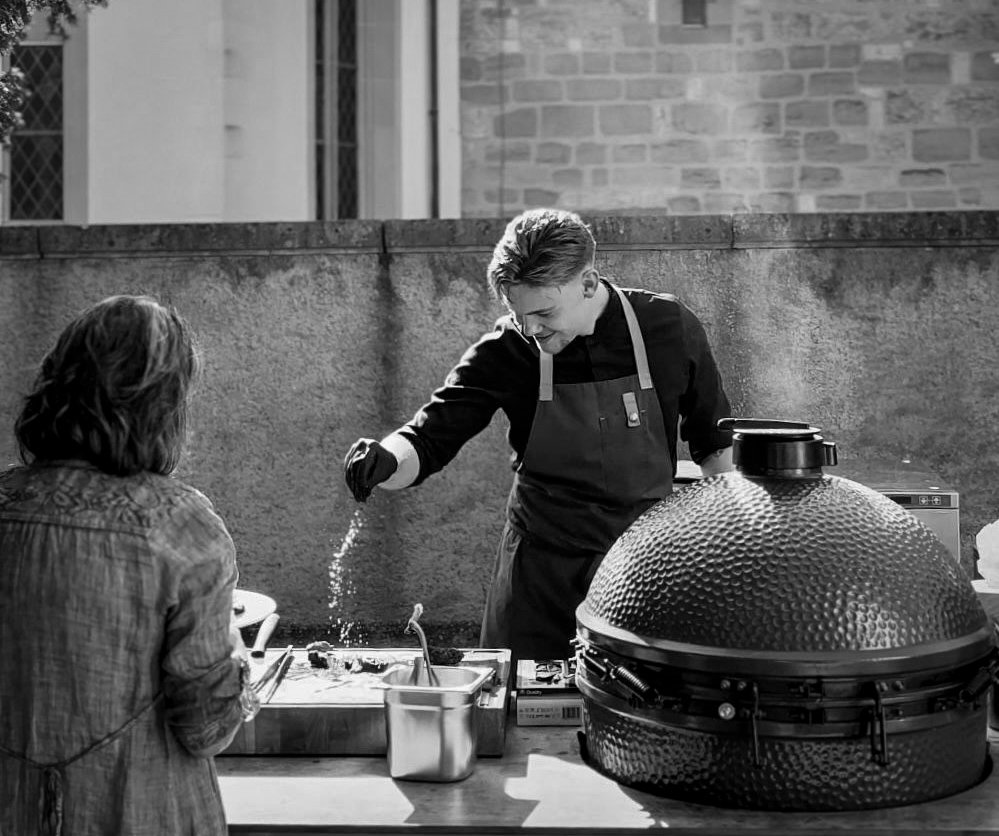
Immanuel Kirisits
Aargau, Switzerland
At just 20 years old, I’m living my dream of being the youngest restaurant owner in Aargau, Switzerland. My father inspired me. Coming from a family where food was central to our lives, I would stand beside him as a small child, watching and learning as he stirred pots and crafted meals. Over the years, I followed my passion, and after earning my chef’s diploma, I had the privilege of training under the two-Michelin-starred Chef Jeffrey van Zijl.
An essential moment in my journey occurred while working with Chef Jeffrey. He taught me how to truly understand the delicate balance of flavors, particularly how to achieve a dish’s perfect acidity and harmony. It was a moment of clarity for me—everything suddenly clicked. I realized that mastering these elements was vital to reaching the excellence I strive for in my cooking. That lesson has stayed with me and continues shaping how I approach every dish I create.
In April 2024, I took over a local restaurant, dedicating myself to using seasonal, locally sourced ingredients and handcrafting everything from sourdough to various fermented products. I wanted complete creative freedom—building a restaurant that reflected my vision. But with that freedom came total responsibility. I didn’t have a boss to turn to—I became that person.
The challenges were immediate. The first few months were grueling: 16-hour workdays, no days off, and constant financial pressure. I had to learn the business side of things quickly—strategy, budgeting, and team management. We make almost everything from scratch, which is time-consuming but necessary for the quality I envisioned. I also had to earn the respect of older, more experienced staff, proving myself as a chef and leader.
Nearly a year after opening, I’ve found more balance, but I’m still learning how to maintain a successful business. My relentless drive to improve, innovate, and reach the highest level of service excellence while staying true to my roots keeps me going. My team sees this—they trust me, respect me, and appreciate the cooperation and leadership I bring, never making my age a factor.
@ochsenschoeftland is just the beginning of my journey.
Inisights from our team:
Our Service Team: It is clear that he is very talented at cooking, however what is even more impressing is his passion for always learning more and improving, innovating and being creative which shows through his work.
Immanuel is admired by the service team, who really respect him and don’t feel any negative impact of the fact that he is so young. They find him very cooperative and trust his leadership. They always feel motivated during stressful times by Immanuel’s positive attitude.
The Kitchen team, formed of dear colleagues of Immanuel from past experiences, find working with him and having him as a leader both fun and challenging. Immanuel creates a pleasant work atmosphere where creativity can run free, but at the same time keeps a strict overview of everything happening in the kitchen. His teammates have so far learned a lot from him, but were also encouraged to use their creativity on their own and create. They respect Immanuel and trust him.
Personally, as a part of the marketing / office team, I see Immanuel as a passionate person who is very involved in every aspect of his business. Even though his great passion is cooking, he actively works hand in hand with the other employees and is always ready to help. Sometimes people don’t see everything “hiding” behind running a business. Be it replying to emails, serving the guests or cleaning the floors, Immanuel is everywhere and even though his favourite place to be is in the kitchen, he does everything else with the same motivation and passion.
About Your City!
- If Anthony Bourdain or a chef came to your city, what would be the perfect tour itinerary from breakfast to dinner?
Start having breakfast in Wynwood at Panther coffee or Zach the Baker, walk around the galleries, discover the graffiti murals in the neighborhood and the boutique and eclectic stores. For lunch time stroll around design district and eat at Le Jardiniere or at Cote. Check out the stores and galleries in the area. Dinner head to South Beach and dine at Stubborn Seed or the iconic Joes Stone Crab.
- Recommended Places in your city:
- Food Markets: pinecrest food market, Yellow, green farmers market
- Cultural Events: art Basel, Coconut Grove art festival, Flamenco festival, jazz in the Gardens
- Neighborhoods: Wynwood, design district, Buena vista
- Popups: Entrenos, Kul Street Food/Food Trucks: Halouver beach food trucks
- Restaurants: Timo, Ossobucco, Itamae
- Cafes: Panther coffee, Imperial moto cafe
Surfing The New Wave Of Costa Rican Cuisine
Kenneth Ruiz Montoya
San Jose, Costa Rica
I was born in San José, Costa Rica, and grew up surrounded by the flavors and natural beauty of my country. My passion for cooking is driven by a desire to honor our incredible local products and to continue contributing to this new wave of Costa Rican cuisine. Amana was born from the desire to make a cuisine without pretensions or luxuries, simply honest and delicious food that reminds us of the richness of our surroundings and the quality of the products we have the privilege to work with.
Over the past nine years, I’ve been lucky to have incredible leaders guide me. Their lessons live in my kitchen today, shaping how I approach food and teamwork. Cooking has taught me a lot about collaboration. I believe that the role of a chef or cook transcends personal achievement. I have come to understand that alone, we can only go so far; it is together that we can truly make a difference. As cooks, we share a common passion and love for our profession, our country, and its natural beauty. By working collaboratively, we can elevate our country’s cuisine and sustainable tourism, putting them on the map.
One of the most pivotal moments of my career happened this year when I competed in the San Pellegrino Young Chef competition. For the first time, I left Costa Rica and traveled to Peru. That experience opened my eyes to the possibilities that cooking offers. Traveling because of my craft was a dream come true, and it reaffirmed that this path is where I’m meant to be.
Looking ahead, I hope to see more thoughtful development in our industry. In Barrio Escalante, where Amana is located, the rise of bars has been a mixed blessing. While it brings energy to the area, I’d love to see these spaces embrace more creative offerings rather than defaulting to overpriced drinks and poor-quality food.
Through it all, I wouldn’t trade this profession for anything. Cooking is a way of life for me. It’s about connecting to the ingredients, people, and stories that come alive through every meal. And for me, it’s always been about Costa Rica and showing the world what our cuisine is capable of.
Bridging Cultures Through Pastry
Humans of the Kitchen
Journey from Traditional Colombian and Jewish Kitchens to Inspiring Future Chefs
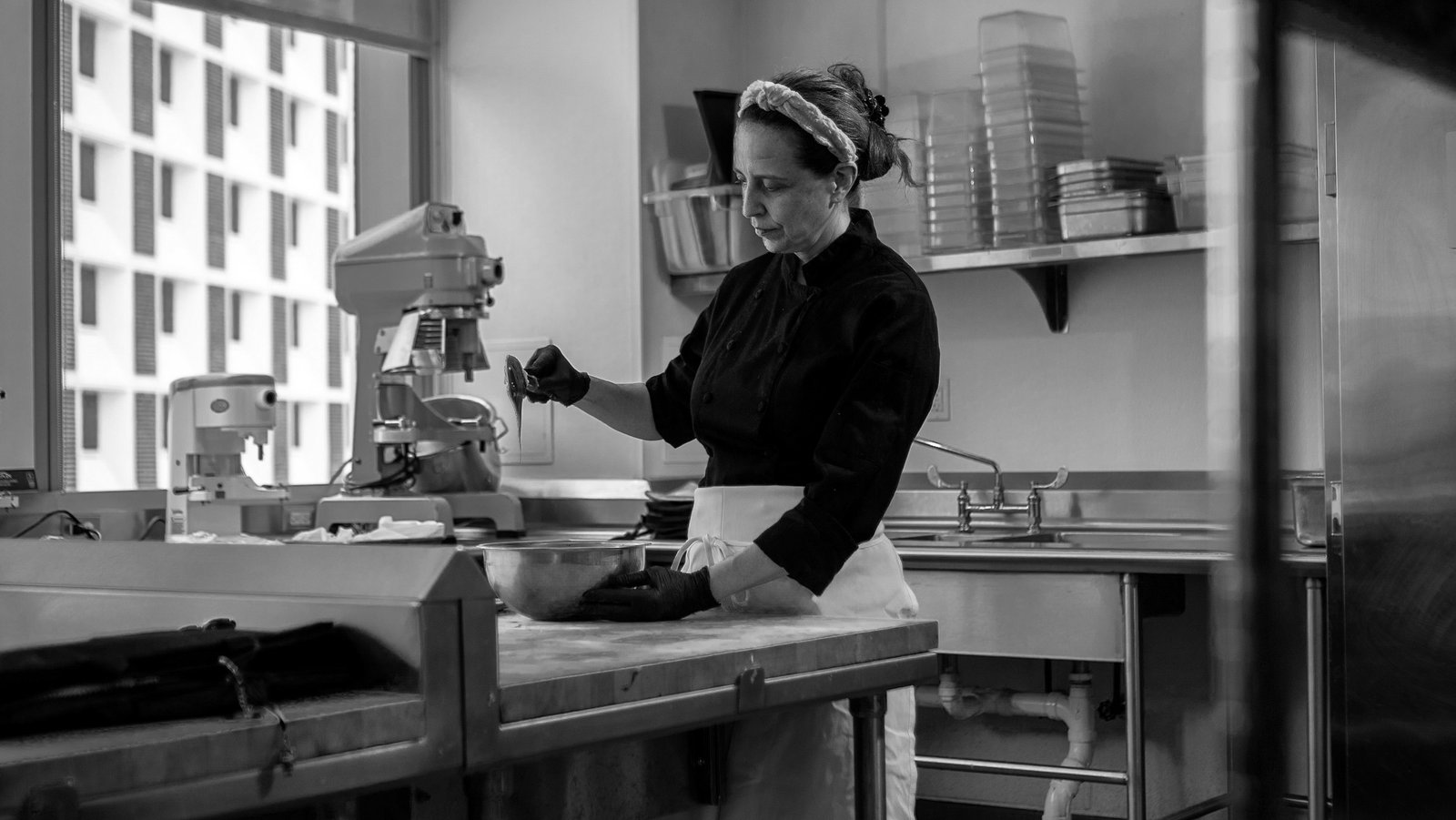
Malka Espinel
Food has been the centerpiece of my life for as long as I can remember. Growing up in Bogotá, Colombia, my earliest memories are of my mother’s cooking and entertainment. In our Jewish household, food was more than sustenance. . Shabbat dinners were sacred—a table filled with traditional dishes, laughter, and stories that connected us to generations past.
My father’s family brought another layer to this culinary tapestry. With roots in Boyacá, they introduced me to farm-to-table cooking. Fresh eggs, milk, and hand-ground corn became arepas, breads, and homemade delicacies. My grandmother, the town baker, made everything from scratch—including unforgettable apple pies. These experiences weren’t just meals but lessons in patience, creativity, and the joy of sharing.
However, cooking as a career wasn’t common in Colombia, especially among women. I pursued food engineering, hoping to stay connected to my passion. Yet, factory work lacked the creativity I craved. That’s when I moved to Chicago to study at The Cooking and Hospitality Institute of Chicago. My first jobs in pastry, including a stage at Charlie Trotter’s and work at Bittersweet Pastry Shop, shaped my path. Encouragement from mentors gave me the confidence to grow in a demanding industry.
My journey expanded to Paris and Barcelona, where I completed stages at Fauchon and Escuela Hoffman, refining my skills. Moving to Miami for a Master’s in Hospitality Management at FIU opened doors to work with renowned chefs like Norman Van Aken and Michelle Bernstein and compete on shows like Iron Chef America and Sugar Rush.
After years of honing my skills in various restaurants, an incredible opportunity presented itself: a chance to teach pastry at a local culinary school. This was the final piece of the puzzle—a way to honor my journey and leave a lasting legacy. Now, you can find me at MDC Culinary, where I teach baking and pastry, sharing the knowledge and experiences that have shaped my career.
However, my passion for the professional kitchen remains strong. I continue to oversee the pastry section at Timo Restaurant, where I manage dessert menus and special events. In my spare time, I run my own business, @malka_creative_delicious, creating custom cakes and catering for special occasions.
Secret Sauce
- What’s the most unexpected ingredient you’ve ever worked with, and how did it change your perspective on cooking?
I participated in the garlic fest and had to create a dessert with garlic. I had to cook it differently to mellow the intensity.
- What’s your “guilty pleasure” meal?
Pizza
- A food trend that you hate and why?
Naked cakes. I feel the cake looks unfinished.
- What’s the craziest shift you’ve ever worked in the kitchen? What happened, and how did you manage to get through it?
I had a breakfast catering for 1000 people when I owned the coffee shop with my brother and we had to pull an all night eat to get ready. The adrenaline gets you through those moments.
- What’s an underrated ingredient and why?
Tropical fruits, I think people are not familiar with them and don’t know how to best use them.
- What’s a must-try dish from your kitchen or the one you’re proudest to have prepared?
The pistachio bar is the most popular dessert on the menu. It has different textures and layers that are delicious.
About Your City!
Miami, USA
1.If Anthony Bourdain or a chef came to your city, what would be the perfect tour itinerary from breakfast to dinner?
Start having breakfast in Wynwood at Panther coffee or Zach the Baker, walk around the galleries, discover the graffiti murals in the neighborhood and the boutique and eclectic stores. For lunch time stroll around design district and eat at Le Jardiniere or at Cote. Check out the stores and galleries in the area. Dinner head to South Beach and dine at Stubborn Seed or the iconic Joes Stone Crab.
- Recommended Places in your city:
Food Markets: pinecrest food market, Yellow, green farmers market
Cultural Events: art Basel, Coconut Grove art festival, Flamenco festival, jazz in the Gardens
Neighborhoods: Wynwood, design district, Buena vista
Popups: Entrenos, Kul
Street Food/Food Trucks: Halouver beach food trucks
Restaurants: Timo, Ossobucco, Itamae
Cafes: Panther coffee, Imperial moto cafe
Dementia and its Therapeutic Insights
Pharmaceutical advances offer a plethora of treatments for various conditions. One such agent is hydroxyzine hydrochloride. It holds promise in treating multiple ailments. Used primarily for anxiety and tension, its impact extends further. Its applications have evolved to encompass other medical areas. Recent research suggests potential roles in dementia and vascular health.
Hydroxyzine Hydrochloride: A Versatile Agent
Hydroxyzine hydrochloride operates as an antihistamine. It combats allergy symptoms, but its sedative effects attract broader use. The drug aids in managing anxiety disorders. Medical professionals often utilize it in preoperative sedation. Its calming effects offer relief in acute emotional disturbances. The therapeutic scope extends to alleviating nausea and vomiting.
In rhinology, the drug's antihistaminic properties benefit patients. It reduces nasal congestion and irritation. Recent studies highlight its use in older adults. Those suffering from mild cognitive impairment show improvement. Research into dementia treatments explores this avenue further. Initial results seem promising for symptom management.
Theophylline 5% Dextrose Injection Excel: Another Perspective
Theophylline 5% dextrose injection excel plays a distinct role in medicine. Primarily used for respiratory diseases, it alleviates symptoms in chronic asthma and COPD. It acts as a bronchodilator, improving airflow. This injection provides relief in acute exacerbations. While its main focus lies in pulmonary care, connections to vascular health emerge.
The blend of theophylline and dextrose holds potential. Improved circulation and energy supply boost recovery. Some research indicates cardiovascular benefits. Combined with hydroxyzine hydrochloride, potential synergistic effects occur. What causes ED in men involves multifaceted factors such as cardiovascular diseases, psychological stress, and hormonal imbalances. Identifying these causes is crucial for effective treatment strategies http://www.treasurevalleyhospice.com/ targeting erectile dysfunction therapeutics. This combination could enhance treatment outcomes. Understanding these interactions remains vital.
Implications in Rhinology and Cognitive Health
Rhinology and cognitive health intersect through hydroxyzine hydrochloride. The drug's antihistaminic effects ease nasal discomfort. This makes it a candidate for nasal polyps and allergic rhinitis. Moreover, its sedative properties support cognitive health research. Xanax side effects sexually male include potential decrease in libido, erectile dysfunction, and difficulties achieving orgasm. For a comprehensive examination of these issues, visit www.currentbiotica.com/ to gain detailed insights into how Xanax impacts sexual health. In mild dementia, the calming effects reduce anxiety and agitation.
Studies explore its influence on vascular dementia. This dementia type arises from cerebrovascular issues. Hydroxyzine hydrochloride shows promise in mitigating symptoms. Improved sleep and reduced tension enhance patient quality of life. The focus on cognitive and vascular health expands therapeutic boundaries.
Combination therapies involving hydroxyzine hydrochloride and theophylline may hold promise. While still under research, the potential is noteworthy. These drugs offer complementary benefits. A holistic approach could enhance care strategies. These findings guide future investigations.
The realm of pharmaceutical interventions continues to evolve. Hydroxyzine hydrochloride emerges as a versatile agent. Its expanding applications in dementia and vascular health signal progress. Ongoing research will unravel further potentials. Each discovery contributes to improving patient outcomes.
Source:
- https://bnf.nice.org.uk/
- https://soignereniledefrance.org
- https://www.iaomc.org/PhilippineEducationCimmission.pdf
- https://www.ebcog.org/publications
- https://www.acog.org/
- https://www.plannedparenthood.org/
- https://journals.lww.com/mcnjourna
- https://www.treasurevalleyhospice.com/value-nurse-practitioner-hospice-care/
Dimitra Badounou
Dimitra Badounou
I’m originally from Corfu, Greece. When I was a kid, I used to make desserts for my family and they were always impressed with my creations. So, I thought, why not give this passion a shot? There are so many ingredients to mix and match, and I love that I can experiment with almost anything that comes to mind.
My culinary journey began when I was 21, and it was tough at first. I had to deal with conflicts with a chef, but despite our differences, she taught me a lot, and she’s still my mentor. At that time, I had to work in the hotel’s fine dining restaurant for dinner service. It was my first time in a demanding job in the hospitality industry. Even though I was just a trainee, I had big expectations and pushed myself to my limits. I worked long shifts and tried to absorb new information to be the best version of myself.
After that experience, I moved to Athens to start my professional career. I had many interviews, met many people in the culinary industry, and eventually landed jobs in two places I had never dreamed of working. I started as a pastry assistant, but before I knew it, I ran the show as the head of the cold kitchen department’s shift. My chef believed in me so much that he picked me to train all the new cooks, even though I wasn’t technically a cook. Then, I moved to Mykonos for a seasonal job. There, I was responsible for preparing all the delicate and technical dishes in the hotel’s kitchen and helping the head chef develop new recipes. It wasn’t easy, though—the head chef thought I was weak at first, but I soon proved him wrong.
Throughout all my experience in this industry, I’ve met some amazing people who believed in me and some who weren’t that nice, but I’m grateful for all the lessons they’ve taught me, especially how to stay calm under pressure. Currently, I live in Crete and have a blast working at @daios_cove. I hope the industry evolves and people start caring more about their jobs. If everyone gives their best, this job would be dreamy.
What is your favorite street food?
Pita Gyros
Which restaurant or food stand do you recommend? (Different from yours) (Add its Instagram handle if possible)
Seeds Restaurant (Athens Greece) @seeds_restaurant
What is your guilty pleasure?
Eating chips
What ingredient do you find overrated?
Black Truffle
What ingredient do you think is underrated?
Lemons
What is your favorite kitchen tool?
My mini Palette knife
What is your worst kitchen nightmare?
Run out of preparations.
Yuu Shimano
Yuu Shimano
I’m from Japan and always dreamed of traveling abroad when I was younger. When I turned 18, I found a culinary school brochure offering overseas training opportunities. I was thrilled and decided to apply to the Tsuji Culinary Institute because of my passion for cooking. I excelled as a top student and even got the chance to study in France. After graduating, I landed my first professional kitchen job at La Villa des Lys in Cannes, a two-Michelin-starred restaurant. I was eager to specialize in classic French cuisine, so I spent seven years on a culinary journey in France.
At 30, I secured a saucier position at the three-Michelin-starred restaurant Guy Savoy. I learned what it means to work at one of the world’s best restaurants there. I felt motivated daily, from dedication to kitchen work to pride in being a chef. After three years, I got offered a chef position at Mifune, a Japanese-French fusion restaurant in NY. I worked there as an executive chef for five years. The company handled the operation and concept. I wanted more creative control, so I recruited my own team to create our unique style, blending Japanese identity into French cuisine.
In 2022, I opened Restaurant Yuu @restaurant_yuunyc and achieved a Michelin star within six months, a source of great pride. Being a Japanese chef specializing in traditional French cuisine in New York City has been challenging. Still, the city’s diverse appreciation for cultures has allowed me to share my message globally. As a child, I wouldn’t say I liked vegetables, but my mom, a great cook, always deliciously prepared them. She frequently made pumpkin soup stewed with other vegetables, which was how I got my vegetables in.
As a chef, I now include it as a welcoming soup in my menu. It warms guests upon arrival and promotes sustainability by utilizing all parts of the vegetables from our other courses. Our restaurant focuses on classic French cooking while incorporating Japanese hospitality and a deep respect for ingredients. My goal is simple: to make our guests happy and earn respect as a chef.
What is your favorite street food?
Taco
Which restaurant or food stand do you recommend? (Different from yours) (Add its Instagram handle if possible)
Blue Hill at Stone Barn
What is your guilty pleasure?
Haribo
What ingredient do you find overrated?
Caviar
What ingredient do you think is underrated?
Japanese Rice
What is your favorite kitchen tool?
Korin Knife
What is your worst kitchen nightmare?
My team and I making the same mistake on a second time. When guests are not satisfied.
Photo 📷 by @jordansapally
Magdalina Stamova
Magdalina Stamova.
.
I come from Plovdiv, a charming place in Bulgaria with an old town full of character. When I was about 40, I moved to the UK because Bulgaria had few jobs and little money. My first job in the UK was as a kitchen porter in Tonbridge, Kent. It was quite a change from my managerial role back home in a food production company. I used to oversee a big team and organize everything down to the smallest detail in a nationwide organization that makes sausages, salami, and other charcuterie products.
Then, I moved to London seven years ago and started working as a prep chef at Parlour in Kensal Green. I begin my day in the kitchen at 8 am, baking soda bread, and finish by 4 pm. Usually, my daughter comes to pick me up from work after collecting my grandson from school. We get to spend long afternoons together as a family. It’s much better than cleaning the plancha at 10 pm after a 13-hour shift. That’s why I love to be a prep cook as I have time in the afternoon for my loved one’s.
I enjoy preparing Chicken Kyivs each week.. However, making hash browns can be messy and is not my favorite task. Regarding the industry, I believe there should be more women in the kitchen. There are only four women at Parlour, including myself, but we need to have more representation. My dreams for the future are pretty simple; all I hope for is good health and happiness.
What is your favorite street food?
I’m a vegan now and mostly eat at home!
Which restaurant or food stand do you recommend? (Different from yours) (Add its Instagram handle if possible)
Somewhere back home in Plovdiv! Bulgarian food and Bulgarian music. It’s called Sunny Beach
What is your guilty pleasure?
I eat salad twice a day! I don’t do guilty pleasure. Two apples is the closest I get.
What ingredient do you find overrated?
Chocolate & Sugar
What ingredient do you think is underrated?
Beans. Bulgarian bean soup is delicious.
What is your favorite kitchen tool?
Robot coupe!
What is your worst kitchen nightmare?
Raw Kyivs!
Photo 📷 🎤 by @darklingcaptures 🇬🇧
Chef Jesus
Cheft Jesus
I’m from El Salvador. I never thought I’d become a cook, as I studied clinical laboratory science back home. Seeking a better future, I left El Salvador and arrived in Miami, where the only doors open to me were in restaurants. I started in the dish pit, washing dishes, and it took me three years to find a place where I truly felt at home. Despite limited options, I knew I had the power to choose the right place. Thirteen years ago, I entered the kitchen of Camilas Restaurante Miami, a Brazilian buffet in downtown Miami, and I haven’t left since.
I remember the early days, learning from kind Brazilian chefs who patiently taught me about their culture and cuisine. Though I never attended culinary school, they shared their expertise and helped me master the most minor details. While food and language differ from what I knew in El Salvador, our shared love of rice and beans united us. I learned enough to become a kitchen manager.
Camilla’s has been a Miami staple for 35 years, offering a taste of Brazil in the heart of the city. Working in a buffet is unique, as we focus on cooking in the morning and prepping in the afternoon. Our goal is always to provide the best for our customers. Cooking has taught me to appreciate many things, like the simplicity of making perfect rice.
As the city continues to evolve, I’m proud to be part of a new generation of cooks. I’m mentoring a young boy, teaching him to cook and wash dishes, just as I was trained. This sense of continuity and fellowship is essential to me and the kitchen. Witnessing the growth of other individuals in the industry and the shared passion for serving good food to people gives me faith in humanity.
Sarah do Vale
Sarah do Vale.
I am a Brazilian who grew up in a restaurant kitchen. My mother and maternal grandmother owned a restaurant and also sold street food. Cooking has always been the primary source of income for my family. My earliest memory of cooking is when I was six years old, and my mother taught me how to fry an egg. I was taught to respect the profession and approach cooking and serving with affection and care. Today, I bring this philosophy to my kitchen and strive for one made with respect, care, and dedication.
I’ve been in this industry for 20 years now, and I still remember my first job as a dishwasher. A moment in the kitchen that marked me forever was when I moved from one state to another to work with a chef I admired. I learned a lot from him, and it was worth pursuing a dream and gaining valuable experience. Even though I was away from my family and friends, it took a lot of courage, but I was rewarded with knowledge and good experiences.
In the future, I hope to see changes in the restaurant industry regarding low wages, inadequate work environments, and excessive working hours. Unfortunately, the industry is not given the respect and attention it deserves. There are still chefs and restaurant owners who believe that the kitchen is a place of humiliation and disrespect, and this needs to change.
What is your favorite street food?
Hot dog
Which restaurant or food stand do you recommend? (Different from yours) (Add its Instagram handle if possible)
@barpadrin @pedemarmelogastronomia
What is your guilty pleasure?
Ruffles flavor BBQ
What ingredient do you find overrated?
Filet mignon and salmon
What ingredient do you think is underrated?
Cuts with bones, like stinco
What is your favorite kitchen tool?
My chef’s knife 8”
What is your worst kitchen nightmare?
Forgetting the gas on or the fryer on

